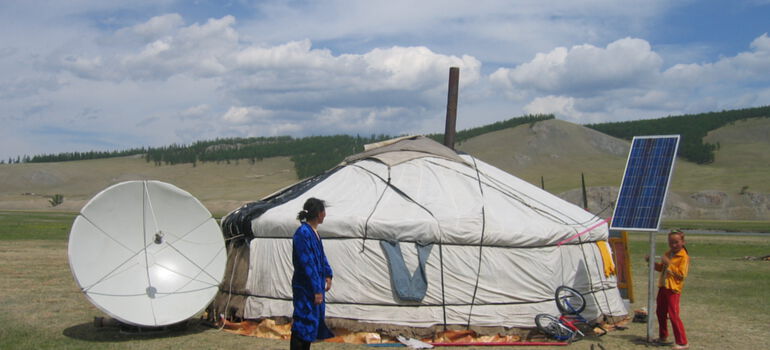To the uninitiated, there can be a bewildering amount of terminology surrounding electricity and electronics. Below I’m going to give a simple description of the most basic terms you need to know to understand and set up your off grid electrical system.
Voltage (Electrical Potential)
Voltage, for formally known as electrical potential, is a basic quality of electricity. It is something like pressure (aka head) in a water pipe.
The higher the voltage, the farther electricity can “jump” when it sparks, and may require thicker plastic coatings to keep it safely contained in wires. For this reason higher voltages are considered potentially more dangerous.
Voltage is measured in Volts (V). Like a distance, a voltage has to be relative to two points. For example, if you say, “How far is London?” you need to know how far from where to answer. For voltage, it is usually measured across the device (the two prongs on a power cord for instance), or between the device and the Earth itself.
In AC systems (more on this below), the voltage never stays still, so meters use a type of average to report the number. Sometimes, to denote this difference people will write Vac or Ṽ instead of just V. You may also see V̄ for DC voltage.
Typical voltages found in the wild:
- 1.65V — AA, AAA, etc, batteries
- 5V — USB chargers
- 12V — Car batteries, Automotive power systems
- 12–48V — Off grid dc power systems, Some RV systems
- 120Vac — US power plugs
- 240Vac — US appliance plugs
- 50,000V — Taser
- 1 billion V — Lightning
Current (Amps)
Current, measured in Amps or Amperes (A), is essentially the amount of electrons flowing per second in the wire. This is a lot like flow rate in a pipe (gallons per minute, aka GPM).
More current means you need thicker wires to handle the load.
Like voltage, amps in AC constantly change and are measured with a type of averaging. For this reason you will sometimes see à for AC amps measurements or Ā.
The amount of current you need is related to the voltage supplied to the device (more on this below). Typical amperage found in the wild:
- 120 mA (0.12A) — Small LED light (@ 120V)
- 500 mA (0.5A) — USB chargers (@ 5V)
- 15–20A — Typical home circuits (@ 120V)
- 30–50A — Large appliances (@ 240V)
- 100–200A — Whole house (@ 240V)
Power (Watts)
Power is th thing you want to get from an electrical system. The more power, the more you can do with your system. Power is measured in Watts. Most solar panels and generators are rated in Watts as well. Power is voltage multiplied by amps:
P = V × A
This makes sense, using a water analogy. If you had a to move a boulder with water, you could move it with a small amount of very high pressure water, like out of a fire hose. But also, a lot of low pressure water, like a flooded creek, can move a boulder just the same.
Most devices need a certain power to operate, and are designed to work at a certain voltage. The current changes based on how much work is actually being done, and may change over time. For instance, a refrigerator will pull max current when it is running, but no current when it is not. Electronics may vary constantly, depending on exactly what they are doing at the moment. Simple devices like lights pull the same amount whenever they are plugged in and switched on.
Every commercially available device will have it’s rated voltage as well as its power and/or current requirements on a tag in the back or on the charger supplied with it. Any power or current specification is an absolute max, and most devices will generally use less.
Energy (Wh or kWh)
Energy is a number that represents power storage. Your electric bill charges you based on how much energy you used. And, battery banks are rated in energy as well.
Energy is measured in W hours (Wh) or kilo-Watt hours (kWh). Kilo just means 1000, so 1 kWh = 1,000 Wh. To get energy, you just multiply the average power by the time of use. So a old fashioned 60W light bulb would use 600 Wh or 0.6 kWh if it was on for 10 hours.
E = P × t
Another example. Let’s say you want to charge your phone for 3 hours. Typical USB chargers can supply max .5A at 5V, so 2.5W, which means after 3 hours you will have used 7.5Wh of energy.

DC vs AC Electricity
In the course of designing an off grid power system, you will definitely come across the concept of alternating current (AC) vs direct current (DC) electricity. The names come from the fact that DC electricity only flows in one direction, where as AC electricity is constantly alternating in both directions.
Every device around us is designed to operate with one of these two types of energy transfer. And quite frequently, there is conversion between the two. Wall sockets in grid tied energy systems are always AC. But, many of the devices around us are commonly DC. For instance all electronics, battery powered devices like phones, and efficient LED lights run internally on DC. Automotive and RV systems are also DC, because they run off battery.
Most importantly for off grid energy systems is the fact that photovoltaic cells (aka solar panels) and batteries only produce DC by the physical nature of how they work.
Generators used in micro-hyrdo or wind applications can be either AC or DC generating. Modern designs generally always produce AC internally, but come with in internal AC to DC converter in the DC models.
Inverters— Converting DC to AC
Because an off grid system naturally runs on DC based electricity, if you want to run traditional wall plug type devices, you will need to convert the DC energy back in to AC. This conversion is accomplished by a device called an inverter.
Large scale, “drop in replacement” off grid power systems will typically include a large inverter as part of the system between the batteries and the load appliances / wall plugs. The inverter is sized so that all DC power will be converted to AC before use, so that it appears as if the house is really a grid tie system to the end user.
However, inverters use up 5% – 15% of all power during the conversion, and so can be a huge extra expense in terms of extra generators, solar cells, and batteries to cover this wasted energy. (The waste comes out as heat in the body of the inverter, which for large models usually need fans to keep them cool.) Off grid systems where cost is an issue may find that they save money buy having both an AC and DC circuit in their homes, and running as much as possible from the DC.


